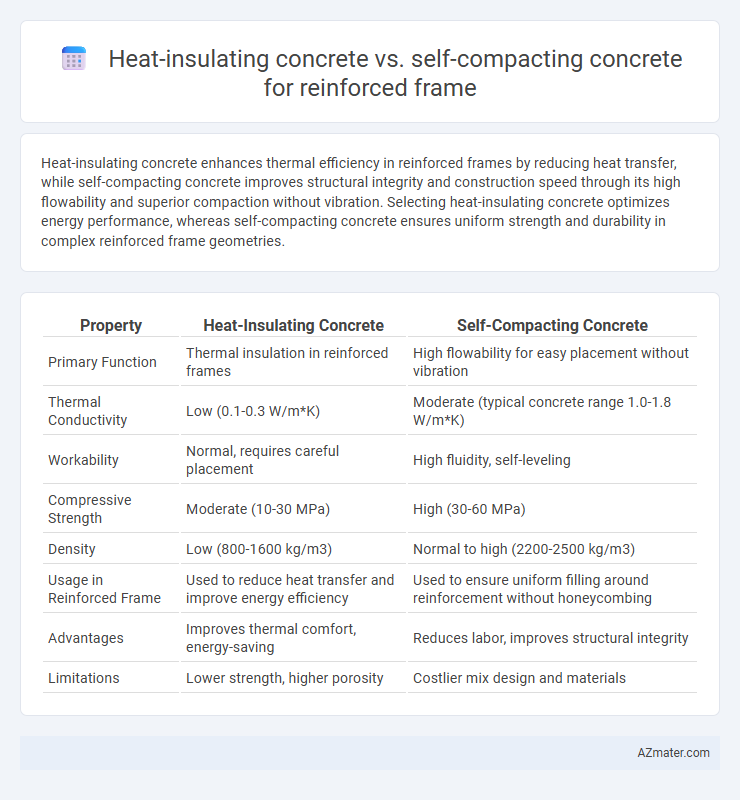Heat-insulating concrete enhances thermal efficiency in reinforced frames by reducing heat transfer, while self-compacting concrete improves structural integrity and construction speed through its high flowability and superior compaction without vibration. Selecting heat-insulating concrete optimizes energy performance, whereas self-compacting concrete ensures uniform strength and durability in complex reinforced frame geometries.
Table of Comparison
| Property | Heat-Insulating Concrete | Self-Compacting Concrete |
|---|---|---|
| Primary Function | Thermal insulation in reinforced frames | High flowability for easy placement without vibration |
| Thermal Conductivity | Low (0.1-0.3 W/m*K) | Moderate (typical concrete range 1.0-1.8 W/m*K) |
| Workability | Normal, requires careful placement | High fluidity, self-leveling |
| Compressive Strength | Moderate (10-30 MPa) | High (30-60 MPa) |
| Density | Low (800-1600 kg/m3) | Normal to high (2200-2500 kg/m3) |
| Usage in Reinforced Frame | Used to reduce heat transfer and improve energy efficiency | Used to ensure uniform filling around reinforcement without honeycombing |
| Advantages | Improves thermal comfort, energy-saving | Reduces labor, improves structural integrity |
| Limitations | Lower strength, higher porosity | Costlier mix design and materials |
Introduction to Innovative Concrete Types for Reinforced Frames
Heat-insulating concrete enhances thermal performance in reinforced frames by integrating insulating materials that reduce energy loss and improve building sustainability. Self-compacting concrete (SCC) offers superior flowability and consolidation without mechanical vibration, ensuring uniform distribution around reinforcement bars and complex formwork. Both innovative concrete types optimize structural integrity and construction efficiency, tailored to specific project demands in modern reinforced concrete applications.
Overview: Heat-Insulating Concrete and Its Core Features
Heat-insulating concrete is engineered with lightweight aggregates and insulating additives to minimize thermal conductivity, making it ideal for reducing energy consumption in reinforced frame structures. Its core features include high thermal resistance, improved fire protection, and reduced heat transfer, which enhance the building's energy efficiency and occupant comfort. This concrete type typically exhibits lower density and compressive strength compared to traditional mixes but compensates with superior insulation properties critical for sustainable construction.
What Is Self-Compacting Concrete? Key Properties Explained
Self-compacting concrete (SCC) is a highly flowable, non-segregating concrete that can spread into place and fill formwork without mechanical vibration, making it ideal for complex reinforced frames. Key properties include excellent workability, high deformability, and resistance to segregation, ensuring uniform encapsulation of reinforcement and consistent structural integrity. Unlike heat-insulating concrete, which focuses on thermal performance, SCC prioritizes ease of placement and enhanced durability in densely reinforced structural elements.
Structural Strength: Comparing Performance in Reinforced Frames
Heat-insulating concrete enhances thermal resistance while maintaining adequate structural strength in reinforced frames, making it suitable for energy-efficient buildings requiring moderate load-bearing capacity. Self-compacting concrete offers superior flowability and uniform compaction around reinforcement, resulting in improved bonding and higher structural performance under dynamic loads. Comparative studies show self-compacting concrete typically demonstrates greater compressive strength and durability in reinforced frames compared to heat-insulating concrete, which prioritizes thermal properties over maximum load capacity.
Thermal Efficiency: Insulation Values and Energy Savings
Heat-insulating concrete offers superior thermal resistance with low thermal conductivity values, significantly reducing heat transfer in reinforced frames and enhancing energy savings in building envelopes. Self-compacting concrete, while primarily designed for flowability and structural performance, typically exhibits moderate insulation properties but may require additional insulation materials to achieve similar thermal efficiency. Utilizing heat-insulating concrete in reinforced frames can optimize energy consumption by maintaining stable indoor temperatures and lowering HVAC demands.
Workability and Ease of Placement in Construction Sites
Heat-insulating concrete offers moderate workability with specific mixes designed to enhance thermal resistance, but it can present challenges in uniform placement due to its lightweight aggregates. Self-compacting concrete (SCC) exhibits superior workability, flowing effortlessly into complex reinforced frames without vibration, significantly reducing labor and placement time on construction sites. The high flowability and stability of SCC ensure consistent coverage around reinforcement, minimizing voids and enhancing the structural integrity of reinforced frames.
Durability and Longevity: Resistance to Environmental Factors
Heat-insulating concrete offers superior resistance to thermal variations, reducing thermal stress and enhancing the durability of reinforced frames in extreme temperature environments. Self-compacting concrete significantly improves structural integrity due to its high workability, ensuring dense, void-free compaction that resists moisture ingress and chemical attacks. Both materials contribute to longevity, but heat-insulating concrete excels against temperature fluctuations, while self-compacting concrete provides enhanced protection against environmental contaminants.
Cost Analysis: Material, Labor, and Lifecycle Expenses
Heat-insulating concrete typically incurs higher initial material costs due to specialized additives enhancing thermal resistance, while self-compacting concrete demands premium pricing for its superior flow properties reducing labor intensity. Labor expenses for heat-insulating concrete rise with careful handling and placement to maintain insulating qualities, contrasting with self-compacting concrete's labor-saving benefits from ease of placement and reduced vibration requirements. Lifecycle costs favor heat-insulating concrete in energy savings and thermal performance, but self-compacting concrete may lower long-term maintenance and repair expenses by ensuring uniform compaction and structural durability in reinforced frames.
Environmental Impact and Sustainability Considerations
Heat-insulating concrete significantly reduces energy consumption in buildings by enhancing thermal performance, leading to lower greenhouse gas emissions over the structure's lifecycle. Self-compacting concrete, while beneficial for reducing labor and improving construction efficiency, typically has a higher cement content, which can increase carbon footprint unless supplemented with eco-friendly additives. Selecting the appropriate concrete type for reinforced frames requires balancing thermal insulation benefits with material sustainability and emissions associated with production.
Choosing the Right Concrete: Recommendations for Reinforced Frame Projects
Heat-insulating concrete enhances thermal efficiency and reduces energy costs in reinforced frame structures, ideal for projects prioritizing sustainability and temperature regulation. Self-compacting concrete improves workability and minimizes labor by filling complex formworks without vibration, essential for intricate reinforced frame designs requiring high precision. Selecting the appropriate concrete depends on project goals: prioritize heat-insulating concrete for energy performance and self-compacting concrete for ease of placement and structural integrity in detailed reinforcement schemes.

Infographic: Heat-insulating concrete vs Self-compacting concrete for Reinforced frame
 azmater.com
azmater.com